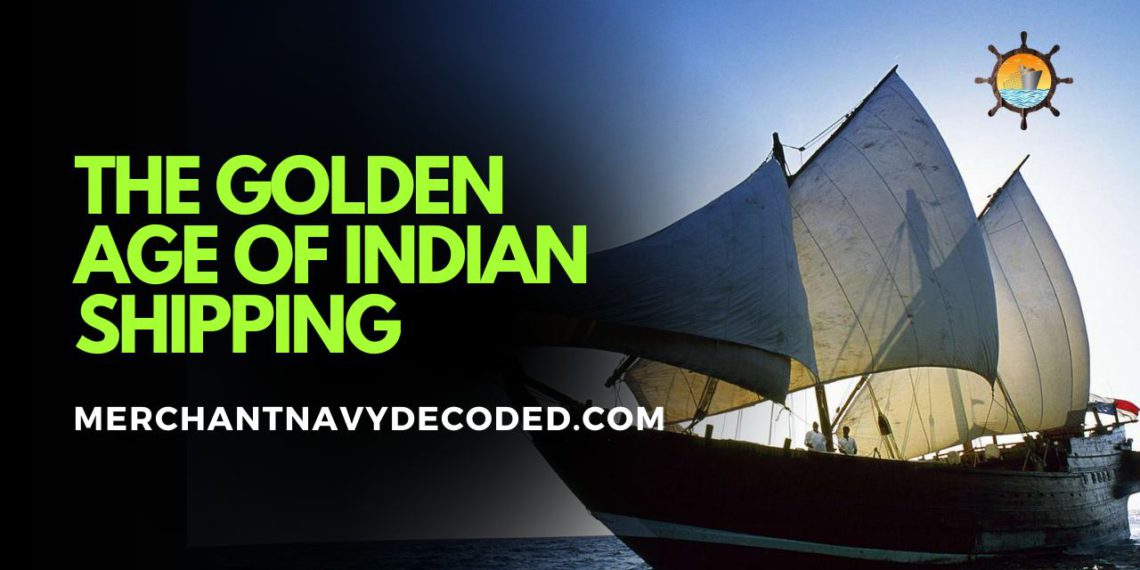The Golden Age of Indian Shipping
Introduction
Indian maritime history has a rich legacy that dates back to around 4000 BC. It’s a story of a nation deeply intertwined with the sea, so much so that the only ocean in the world named after a country is the ‘Indian Ocean.’
One remarkable milestone in this journey was the discovery of the world’s first drydock in Lothal, Gujarat, around 2400 BC. This ancient drydock stands as a testament to India’s early prowess in shipbuilding and maritime technology.
As we delve into the pages of history, we’ll explore the rise and fall of Indian shipping from 4000 BC to 1900 AD, uncovering the remarkable achievements and challenges faced by this seafaring nation
The Glorious Epoch of Indian Shipping
Chandra Gupta Maurya’s Maritime Reforms (321 to 297 BC)
In the annals of Indian maritime history, a significant milestone emerged during the reign of Chandra Gupta Maurya, who ruled from 321 to 297 BC. During his reign, Chandra Gupta Maurya introduced groundbreaking reforms that separated the naval department from general shipping operations. This innovation gave birth to the concept of the Indian Merchant Navy, marking a crucial step in the evolution of India’s maritime prowess.
The Chola Dynasty’s Maritime Dominance (9th to 13th Century CE)
- Fast forward to the 9th century, when the Chola dynasty ascended to the zenith of its power. While the Cholas did not possess a modern standing navy as we know it today, they harnessed the maritime potential of their time by utilizing ships primarily designed for trade.
- Southern India, by this time, had become a hub of extensive maritime and commercial activities, fostering robust connections, particularly with the Chinese and Arabs. The Chola naval forces were at the forefront of this maritime surge.
- One of their most remarkable achievements was the invasion and conquest of Srivijaya, a vast maritime empire in Southeast Asia. This conquest showcased the Cholas’ mastery of naval tactics and their dominance in the Indian Ocean region.
- During this period, Indian goods and ideas began to play a pivotal role in the Indianization of the wider world. The Cholas excelled in foreign trade and maritime activities, expanding their influence across the seas and reaching as far as China and Southeast Asia.
The era of Chola dominance stands as a testament to India’s maritime glory, marked by trade, conquest, and the propagation of Indian culture beyond its shores.
The rise of Indian merchant shipping
- As early as the 13th century, the famous Venetian explorer Marco Polo (1254-1324) marveled at the Indian ships of his time. According to Marco Polo, these vessels were not only impressive but also incredibly durable. He noted that Indian ships were built to last a staggering 100 years, a testament to the advanced shipbuilding techniques employed by Indian craftsmen.
- What set Indian ships apart was their sheer size and capacity. Some of these vessels were so colossal that they required crews numbering in the range of 150, 200, or even 250 sailors. These large crews were necessary to handle these massive vessels and navigate the vast Indian Ocean.
- A significant turning point came when the Chinese admiral Zheng He (Cheng Ho) ventured to India in the closing years of the 14th century AD. To his astonishment, Zheng He discovered that the ships of his fleet, though impressive by Chinese standards, were mere midgets when compared to the colossal Indian ships that plied the waters of the Indian Ocean.
Rise of Indian Shipping during Emperor Akbar’s Reign
The decline of Indian merchant shipping is a significant chapter in our maritime history. According to records from the Ayeen-Akbari, during the reign of Emperor Akbar from 1556 to 1605, Indian shipping was administered quite effectively. Around 4,000 Indian ships were known to be active in and around the Indian Ocean during this period, a testament to India’s maritime strength.
Downfall of Indian Shipping
However, the downfall of Indian shipping would eventually come. Notably, the Bhavnagar-built Indian ship ‘Daria Daulat’ continued to sail soundly even after 87 years of active service. This demonstrated the superior craftsmanship of Indian ships.
Impact of British Navigation Act
The famous British Act of Navigation in 1651 marked a turning point. This act restricted the importation of goods from Asia, Africa, or America into England, Ireland, or its plantations, unless the majority of the crew and the master were Englishmen. This policy put Indian merchant shipping at a disadvantage and played a role in its decline.
Decline of Indian Merchant Shipping| Governor General of Fort William

- In a significant turn of events, the decline of Indian merchant shipping was marked by an order issued by the Governor General in Council of Fort William’s Revenue Department.
- On January 14, 1789, this proclamation was made, which stated that from March 1st onwards, all individuals, including those expected to be magistrates in the district, were strictly forbidden from making or using boats of specific names and sizes. This played a pivotal role in shaping the course of Indian maritime history
Consequences
The consequences were severe for those in the regions of Jessore, Dacca, Jahalpore, Mymensingh, Chittagong, Parganas, Higelle, Tumlook, Burwan, and Nuddea.
They were directed to take action regarding boats of a specific description:
- Seizure and Confiscation: The magistrates of these areas were instructed to seize and confiscate any boats that matched the aforementioned description found within their respective jurisdictions.
- Zamindars’ Responsibility: Any zamindar who allowed boats of this description to be constructed or repaired within their zamindary territory without a written order from the district magistrate would face consequences.
- Village Accountability: The government held the village responsible where such boats were proven to have been built or repaired.
- Restriction on Artificers: Carpenters, blacksmiths, or other artisans who engaged in building or repairing boats of the specified description without express permission from the district magistrate would face penalties.
Penalties
- Imprisonment: Offenders could be committed to close imprisonment in the Foujdari jail for a period not exceeding one month.
- Corporal Punishment: Offenders might also receive corporal punishment, not exceeding 20 strokes with a rattan.
These measures were put in place to regulate and control boat construction and repair activities in the mentioned regions, likely to maintain order and oversight in the maritime heritage of India during that historical period.
Conclusion
- In conclusion, the history of Indian shipping is a tale of remarkable resilience, innovation, and ultimately, subjugation. Between 1860 and 1925, a staggering 102 Indian shipping companies were registered in India, representing an estimated investment of over 40 crores.
- However, the British colonial authorities systematically dismantled this flourishing industry. One by one, these Indian shipping companies were forced into liquidation. It’s a stark contrast to the scene in 1857 when 34,286 Indian ships entered and cleared our ports, carrying a total of 1,219,958 tons of cargo. Yet, by 1900, only 1,676 ships managed to do the same, transporting a mere 103,813 tons.
“ Mahatma Gandhi described that Indian shipping had to perish so that British shipping might flourish. This harsh reality underscores the extent to which colonial powers exploited and suppressed indigenous industries to bolster their interests.”
- While the Indian shipping industry faced a decline during this period, it’s essential to remember the spirit of resilience that has always characterized the Indian people. The maritime history of India serves as a testament to the nation’s enduring strength and its ability to overcome challenges, both past and present.
Disclaimer :- The opinions expressed in this article belong solely to the author and may not necessarily reflect those of Merchant Navy Decoded. We cannot guarantee the accuracy of the information provided and disclaim any responsibility for it. Data and visuals used are sourced from publicly available information and may not be authenticated by any regulatory body. Reviews and comments appearing on our blogs represent the opinions of individuals and do not necessarily reflect the views of Merchant Navy Decoded. We are not responsible for any loss or damage resulting from reliance on these reviews or comments.
Reproduction, copying, sharing, or use of the article or images in any form is strictly prohibited without prior permission from both the author and Merchant Navy Decoded.



